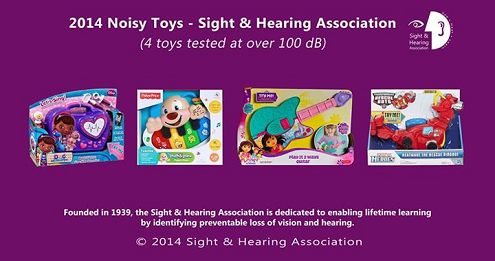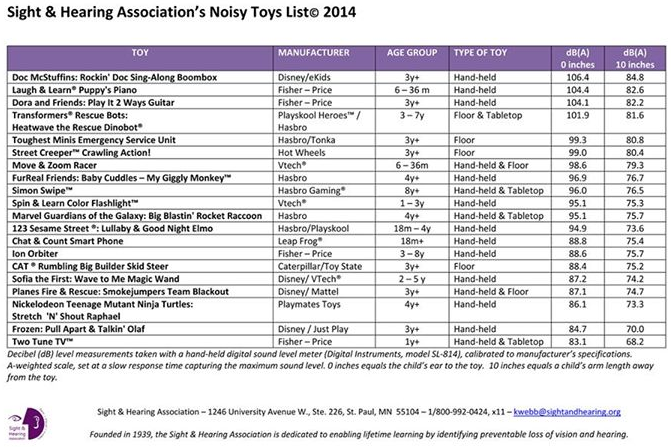November 26, 2014 - Saint Paul, MN – 18 out of 20 toys tested are louder than 85 dB, the level set by the National Institute of Occupational Health and Safety for mandatory hearing protection.
While no one wants to be considered a Grinch during the holiday season, Sight & Hearing Association (SHA) gladly takes the responsibility in their 17th Annual Noisy Toys Study™, warning consumers that the loud toys we find on the toys shelves this holiday season unnecessarily expose children to decibel levels that can be damaging. Of 20 toys tested this year, 18 of them would have the Grinch screaming, “Oh, the noise! Noise! Noise! Noise!” Among the 18 loudest toys, four screamed above 100 decibels (dB), which can damage hearing in less than 15 minutes. Shockingly, the loudest toy tested this year is among the popular DocMcStuffins toy line, a Rockin’ Doc Sing-Along Boombox that peaks at 106.4 dB, when placed at a child’s ear. Doc needs to stop rockin’ and start prescribing musician earplugs for this bombastic Boombox! At press time, Disney/eKids had not responded to SHA’s concern about the noise level of this toy intended for children 3-years-old and up.

Sight & Hearing Association - 2014 Noisy Toys Study™ | Copyright 2014 Sight & Hearing Association (https://www.sightandhearing.org)
With sound level meter in hand, SHA shops for and selects toys that sound too loud for consumers and occasionally they will find a few that pass the test. Among the toys selected this year, SHA identified two that are ear-friendly: Pull Apart & Talkin’ Olaf from Disney’s Frozen toy line and a remade vintage toy from the 1960’s,Two Tune TV™, both measure under 85dB. According to the National Institute of Occupational Health and Safety (NIOSH), exposure to noise levels above 85 dB for no more than eight hours is the federal threshold for hearing protection. SHA reminds consumers that hearing loss is cumulative and it typically does not occur from one event; it gradually develops over time as we age and it is critical we protect young children's hearing. If you own a smartphone, any consumer can download a sound level meter application that measures the sound level of a toy. SHA suggests, “If you don’t own a smartphone, your ears will do just fine. The rule of thumb is, if a toy sounds too loud to you, it is too loud.”
Toys are required to meet the acoustic standard set by the American Society of Testing and Materials, which states that the sound-pressure level produced by toys shall not exceed 85 dB at 50 cm from the surface of the toy. “What is interesting about this standard is that 50 cm is longer than the average arm length of an adult. We test toys based on how a child would play with a toy, not how an adult would play with it. If you watch a child playing with a noise-producing toy, you will see them hold it close to their face, next to their ears or closer than arm’s length and arm’s length for a child is approximately 10 inches (25 cm)”, explains Kathy Webb, Executive Director of SHA.
Webb recommends you “Test a toy before you buy it. It’s okay to push buttons and rattle toys as you walk through the toy aisle and if a toy is too loud for you, it will be too loud for your child. Look for toys that have volume controls and if you must buy a noisy toy this holiday season, or your child receives a noisy toy as a gift, you can place clear packing tape over the speaker which will reduce the sound level enough to make the toy ear-safe.” A study by the University of Minnesota/Department of Otolaryngology confirmed that covering the speaker(s) of noise-producing toys with tape or glue will significantly reduce the noise level of a toy, making it safer for children.
Founded in 1939, Minnesota-based Sight & Hearing Association is dedicated to enabling lifetime learning by identifying preventable loss of vision and hearing. For more information or if consumers have a noisy toy to report, contact SHA at kwebb@sightandhearing.org, the Consumer Product Safety Commission at (800) 638-2772 or www.saferproducts.gov.
If you would like to receive a pdf copy of the complete 2014 Noisy Toys Study™, please contact SHA at kwebb@sightandhearing.org.


